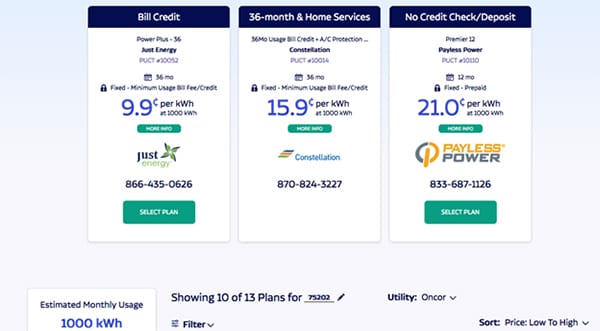
Do you think your energy bill is too high and have decided to switch energy suppliers? If yes, the beauty of Texas’ deregulated energy system is that you can do just that.Do you think your energy bill is too high and have decided to switch energy suppliers? If yes, the beauty of Texas’ deregulated energy market is that you can do just that.
A few initial online search inquiries will probably return multiple price comparison websites. However, trying to work out if you’re better off using less energy, finding a supplier with lower energy costs, or simply sticking with your current deal can feel overwhelming.
Comparing prices is tricky; comparing price comparison websites adds another layer to the energy puzzle. But have no fear. At EnergySavings.com, we’re committed to helping people and businesses with their energy usage.
This EnergySavings.com vs. Choose Energy guide will help you compare those that compare, clearing up the jargon and leading you to lower electric bills. Looking at EnergySavings.com vs. Choose Energy, we’ll explain the similarities and differences between these two companies.
EnergySavings.com vs. Choose Energy in Texas: Why Change?
The first question for many people may be, “Why change energy suppliers?”
In Texas, around 85% of residents live in deregulated energy market areas. Deregulation brings choice. The Lone Star State has more than 140 retail electric providers (REPs). Collectively, these REPs advertise hundreds of energy deals to try to win business.
People living in what are called regulated service areas have their REP chosen for them by the Public Utility Commission of Texas (PUC or PUCT).
Texas’ business and residential customers that can choose their electric company need an easy way to compare offers available. That’s where price comparison companies step in. This EnergySavings.com vs. Choose Energy article is part of an essential understanding of how to find the best energy deal.
EnergySavings.com vs. Choose Energy: Who Are They?
EnergySavings.com and Choose Energy share several features. They’re official energy brokers — intermediaries between electric companies and customers — registered with the Public Utility of Commission of Texas.
An energy broker displays companies’ products on their website. Customers can help energy brokers generate income by visiting their websites, clicking on deals on offer, getting in touch, or signing up for a product.
Both EnergySavings.com and Choose Energy are experts in the energy resources field. On top of energy prices, they publish information about renewable energy, energy consumption, and energy use, to name a few. People can find articles about energy efficiency and energy-saving tips.
EnergySavings.com
- Part of Interactive Energy Group
- Headquarters in Plano, Texas
- Specializes in Texas-related electricity plans, energy-efficiency measures, and news
- More than 20 years of experience in the Texas energy market
- Free to use
Choose Energy
- Headquarters in Fort Mill, South Carolina
- Part of Choose Energy Inc, a Red Ventures Company
- Specializes in energy plans across 14 states, offering electricity and natural gas
- Operating in Texas since 2008
- Free to use
EnergySavings.com vs. Choose Energy: How Do They Make Money?
Transparency is vital to both EnergySavings.com and Choose Energy. As energy brokers, they make money from the companies whose deals they publicize rather than from browsers.
People visiting the EnergySavings.com and Choose Energy websites may click on links, call energy companies, apply for products, or submit personal information. These interactions bring income to EnergySavings.com and Choose Energy. They also collect a payment from energy providers once any new service begins.
Choose Energy also receives money from companies posting advertisements on their website.
As independent energy brokers, both EnergySavings.com and Choose Energy claim to publish independent, unbiased, and accurate information. Advertisers do not control or guide editorial content.
EnergySavings.com vs. Choose Energy vs. Power to Choose
Many people looking to upgrade their purchasing power in the energy market use PUCT’s official price comparison website, Power to Choose, as a starting point.
EnergySavings.com offers a portfolio of articles about how to use Power to Choose. Choose Energy also has an article about PUCT’s price comparison website. So the question for people looking to switch suppliers may be, “Should I use EnergySavings.com vs. Choose Energy vs. Power to Choose?”
Power to Choose is just one way to look for a new energy supplier. Price comparison websites like EnergySavings.com and Choose Energy are representative of deregulation. Other websites bring fresh perspectives and sometimes a more user-friendly search system.
Let’s see the result of an EnergySavings.com vs. Choose Energy search for electricity rates for residential customers.
Enter your ZIP Code and compare electricity rates
What to Know Before Using Price Comparison Websites
Understanding a utility bill is vital when it comes to switching suppliers. Know the following before changing plans.
Texas electric rates are advertised in kilowatt-hours (kWh). Learn your monthly kWh usage and when you use electricity. Do you use it most during peak hours or off-peak? Approximate per-month kWh usage figures are 500 (low), 1,000 (medium), and 2,000 (high). Ensure you can reach minimum usage prices or risk being charged a higher rate.
Also, decide if you want a fixed-rate or variable-rate contract. Think about your living needs. A long-term contract may carry a low kWh price but expensive termination fees. Time-of-use deals may promote free electricity on weekends and at night, but that won’t help your bill if you regularly use the air conditioning during the day.
Decide if you want a renewable energy element to your electricity supply to help reduce your carbon emissions. Finally, check for hidden fees like deposits and utility fees not included in the advertised rate.
EnergySavings.com vs. Choose Energy: A Comparison
We searched for ZIP code 75202 (Dallas) on Nov. 23, 2022, for 1,000 kilowatt-hours (kWh) monthly usage. Note that the results below can change without prior notice.
Before we look at the results, know that there’s an essential difference in how EnergySavings.com and Choose Energy operate. EnergySavings.com finds offers and redirects you to deal directly with that electric company. Choose Energy asks for more information and can perform the entire transaction for customers.
EnergySavings.com’s helpful filter includes the following:
- Minimum usage levels
- Alter monthly kWh amount
- Renewable energy additions
- Time-of-use choices like free electricity in the evening or on weekends
- Length of contract
- Fixed or variable rates
- Exploring by energy provider
There are search filter tips for people moving homes or those switching suppliers.
Choose Energy’s filter offers the same information but also offers ranking by customer ratings.
Comparison of Rates: EnergySavings.com vs. Choose Energy
Both businesses return recommended plans for the 75202 area, with brief offer descriptions and further options listed below. The companies highlight useful information like contract length, anticipated average monthly electricity bill, price per kWh, the energy company in question, and whether it’s a fixed-rate or variable-rate deal.
Remember: Neither EnergySavings.com nor Choose Energy provides electricity or generates power at power plants. They show electric company deals so people can compare and decide whether to switch.
EnergySavings.com found the following for ZIP code 75202:
- Prices between 9.9 and 21 cents per kWh
- Contracts lasting six to 60 months
- Fixed-rate, minimum usage, and prepaid offers
- At least 13 different energy plans
Choose Energy found the following for ZIP code 75202:
- Prices between 12.1 and 22.3 cents per kWh
- Contracts lasting one to 36 months
- Fixed-rate, minimum usage, and prepaid offers
- At least 60 different energy plans
Choose Energy’s list of offers automatically defaulted to those from Payless Power, resulting in just two energy plans showing. This filter was removed to reveal all 60 plans found.
Top tip: Always read every offer’s Electricity Facts Label (EFL) before signing anything. EFLs detail a contract’s terms and conditions.
EnergySavings.com vs. Choose Energy: The Similarities
Price comparison websites have some inevitable overlap in their search results and services.
EnergySavings.com vs. Choose Energy similarities:
- Show estimated monthly electricity bills based on the information given
- Free to use
- Show, compare, and filter Texas energy rates
- Advertising-recommended energy plans through its search tool
- Act as energy brokers and generate income from energy companies and advertisers
- Publish energy-efficiency advice
- Explain Texas’ deregulated energy market and infrastructure
- Provide information about switching energy companies
- Talk about renewable energy
EnergySavings.com vs. Choose Energy: The Differences
However, the same search filters for ZIP code 75202 returned very different results. There are some notable differences between EnergySavings.com vs. Choose Energy.
EnergySavings.com is distinct from Choose Energy via:
- Concentrating on the Texas electricity market
- Directing referrals to energy companies to permit clear communication
- More in-depth energy information related to Texas-only energy issues
- Not collecting personal information
- Offering a newsletter
Choose Energy is distinct from EnergySavings.com through:
- Advertising natural gas products as well as electricity
- Completing energy switches or sign-ups through its website
- Defaulting its Texas electricity plan finder tool to show pre-selected energy companies
- Working in 14 states nationwide, including Texas
- Helping people with solar panel information, including finding installers
EnergySavings.com vs. Choose Energy for Business Customers
These two price comparison websites differ in their approach to business customers.
In Texas, EnergySavings.com asks business owners to contact its experts directly to discuss a tailored energy solution. It asks for some basic business details, including contact details, current approximate utility bill cost, and ZIP code. An industry specialist will then get in touch to find the most appropriate deal.
Choose Energy covers up to 14 states, offering natural gas as well as electric plans. It has a ZIP code search tool to show the basics before asking for company contact details. Businesses can sign up via Choose Energy’s website without any advice.
Alternatively, business owners can contact Choose Energy directly and wait for up to 10 customized plans based on energy use.
More Information About EnergySavings.com vs. Choose Energy
These companies operate in the same energy sphere, yet a quick product search yielded different results. EnergySavings.com and Choose Energy diverge in other ways, from their specialties to services.
EnergySavings.com vs. Choose Energy: Natural Gas
EnergySavings.com doesn’t offer plans for natural gas products to business or residential customers. The vast majority of Texas residents cannot switch natural gas suppliers, so EnergySavings.com’s specialty is electricity in Texas.
Choose Energy does offer natural gas products to eligible customers in relevant deregulated states. Entering a ZIP code on its website shows if your service area is deregulated and will show relevant natural gas deals. Note that Texas residents cannot choose their natural gas supplier.
EnergySavings.com vs. Choose Energy: Serving Which States?
EnergySavings.com focuses its knowledge and expertise on Texas only and just for electricity.
Choose Energy serves 14 states with electricity or natural gas offers, or both. Choose Energy’s overall remit includes these states:
California, Connecticut, Delaware, Georgia, Illinois, Maine, Massachusetts, Maryland, Michigan, New Hampshire, New Jersey, New York, Ohio, Pennsylvania, Texas, and Washington, D.C.
EnergySavings.com or Choose Energy for Solar Energy?
There are two ways to answer this question.
Firstly, both businesses offer electricity deals that may come with renewable energy elements. This may include electricity generated by solar energy. In fact, Texas’ solar power potential is on the rise, with it producing the second-most solar photovoltaic (PV)-sourced power in the U.S. last year, behind California.
Secondly, while EnergySavings.com has some articles about solar power, Choose Energy has a dedicated solar energy section. Choose Energy gives information about everything from how solar panels work to installation costs.
EnergySavings.com vs. Choose Energy: Who Has the Best Blog?
Honesty, transparency, and editorial independence are the bottom lines for both of these price comparison websites.
Choose Energy’s website has many articles and resources covering everything from hurricane preparations to what to do in case of power outages. The company says advertisers do not influence its editorial policy. However, it admits that some ads or companies may appear in its articles.
EnergySavings.com positions itself as a residential energy expert through its publications. Regular blogs cover everything from clean energy to electric vehicles to reducing energy waste. Its energy news section delivers detailed insights and analysis of Texas electricity prices. There is valuable advice about energy-related financial incentives, grants, and rebates. There’s also a regular newsletter covering energy news and offers.
Other energy FAQs EnergySavings.com answers include:
- Using a thermostat or smart thermostat to reduce energy consumption for space or water heating
- Explaining energy-efficient appliances that carry the ENERGY STAR label, from washers and hot water heaters to clothes dryers and HVAC and air conditioners
- The lowdown on light fixtures, from energy-efficient light bulbs, like LEDs, to incandescent bulbs
- Weatherstripping and how it helps save energy
How to Contact EnergySavings.com and Choose Energy
EnergySavings.com provides impartial information and doesn’t get involved in signing up new customers. Its employees focus on bringing valuable energy-saving tips alongside finding the best electricity rates in Texas. It counts on its customer support team to answer any queries via its email, support@energysavings.com.
Helpful numbers on its website include Texas utilities in case of outages, perhaps from downed power lines, and contact details for the Public Utility Commission of Texas (PUCT). Several Texas electric company phone numbers are also listed.
Choose Energy features a customer service email, Facebook, Twitter, and a phone number to call. It also lists PUCT and REP contact details. Its customer service section is on-hand to answer peoples’ queries about its services.
EnergySavings.com vs. Choose Energy: The Conclusion
Price comparison websites are more than just displaying all or the lowest energy deals. They must show added value and care for customers through additional information and support. And, crucially, their websites need to be user-friendly.
EnergySavings.com specializes in everything electricity in Texas. It drills down into all the essential details about electricity that anyone needs in the Lone Star State through its blog and supporting literature.
Choose Energy has a broader business and service base, covering electricity, natural gas, and solar panel installation in up to 14 states nationwide.
That said, both companies have excellent electricity plan search tools. EnergySavings.com prefers to send customers to deal directly with energy companies, while Choose Energy is more of a one-stop shop.
And remember, if a deal looks too good to be true, it probably is. Always ask yourself these questions before switching electricity suppliers.




